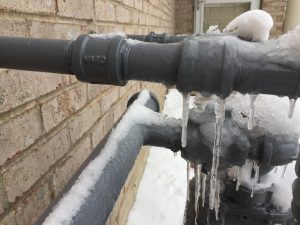Essential Approaches for Avoiding Frozen Pipes in Winter
Essential Approaches for Avoiding Frozen Pipes in Winter
Blog Article
They are making a number of good pointers about How to prepare your home plumbing for winter weather as a whole in the article further down.

Winter can damage your pipes, specifically by freezing pipelines. Here's how to avoid it from taking place and what to do if it does.
Introduction
As temperatures drop, the threat of frozen pipes rises, potentially causing costly repair services and water damage. Comprehending just how to stop icy pipes is critical for house owners in cold climates.
Avoidance Tips
Shielding at risk pipes
Cover pipelines in insulation sleeves or make use of warm tape to safeguard them from freezing temperature levels. Focus on pipes in unheated or exterior areas of the home.
Heating techniques
Maintain indoor spaces appropriately heated, especially areas with plumbing. Open up cupboard doors to permit cozy air to distribute around pipelines under sinks.
Exactly how to determine icy pipes
Search for reduced water flow from faucets, unusual smells or noises from pipes, and visible frost on subjected pipes.
Long-Term Solutions
Architectural changes
Consider rerouting pipelines far from outside walls or unheated locations. Include extra insulation to attic rooms, basements, and crawl spaces.
Upgrading insulation
Buy top notch insulation for pipelines, attics, and wall surfaces. Appropriate insulation helps keep regular temperatures and minimizes the threat of icy pipelines.
Safeguarding Exterior Pipes
Yard hoses and outdoor faucets
Separate and drain yard tubes prior to wintertime. Install frost-proof faucets or cover outdoor taps with shielded caps.
Recognizing Icy Pipes
What triggers pipes to freeze?
Pipelines freeze when subjected to temperature levels listed below 32 ° F (0 ° C) for expanded periods. As water inside the pipes ices up, it broadens, putting pressure on the pipe walls and possibly causing them to break.
Dangers and problems
Frozen pipelines can bring about supply of water disruptions, building damages, and expensive repair work. Ruptured pipes can flooding homes and create substantial architectural damage.
Signs of Frozen Pipes
Determining icy pipes early can prevent them from rupturing.
What to Do If Your Pipelines Freeze
Immediate activities to take
If you think frozen pipelines, keep taps available to relieve pressure as the ice melts. Utilize a hairdryer or towels soaked in hot water to thaw pipelines slowly.
Final thought
Stopping icy pipelines requires aggressive actions and quick actions. By comprehending the causes, indications, and preventive measures, home owners can secure their pipes during cold weather.
5 Ways to Prevent Frozen Pipes
Drain Outdoor Faucets and Disconnect Hoses
First, close the shut-off valve that controls the flow of water in the pipe to your outdoor faucet. Then, head outside to disconnect and drain your hose and open the outdoor faucet to allow the water to completely drain out of the line. Turn off the faucet when done. Finally, head back to the shut-off valve and drain the remaining water inside the pipe into a bucket or container. Additionally, if you have a home irrigation system, you should consider hiring an expert to clear the system of water each year.
Insulate Pipes
One of the best and most cost-effective methods for preventing frozen water pipes is to wrap your pipes with insulation. This is especially important for areas in your home that aren’t exposed to heat, such as an attic. We suggest using foam sleeves, which can typically be found at your local hardware store.
Keep Heat Running at 65
Your pipes are located inside your walls, and the temperature there is much colder than the rest of the house. To prevent your pipes from freezing, The Insurance Information Institute suggests that you keep your home heated to at least 65 degrees, even when traveling. You may want to invest in smart devices that can keep an eye on the temperature in your home while you’re away.
Leave Water Dripping
Moving water — even a small trickle — can prevent ice from forming inside your pipes. When freezing temps are imminent, start a drip of water from all faucets that serve exposed pipes. Leaving a few faucets running will also help relieve pressure inside the pipes and help prevent a rupture if the water inside freezes.
Open Cupboard Doors
Warm your kitchen and bathroom pipes by opening cupboards and vanities. You should also leave your interior doors ajar to help warm air circulate evenly throughout your home.
:strip_icc()/snow-outdoor-faucet-pipes-4af65d1e5e904fb1aa7bf74071fe5d89.jpg)
I ran across that blog entry on Winter Plumbing Precautions: Preventing Frozen Pipes while browsing the search engines. Do you know another person who is in to the topic? Please feel free to share it. Bless you for your time. Return soon.
View Website Report this page